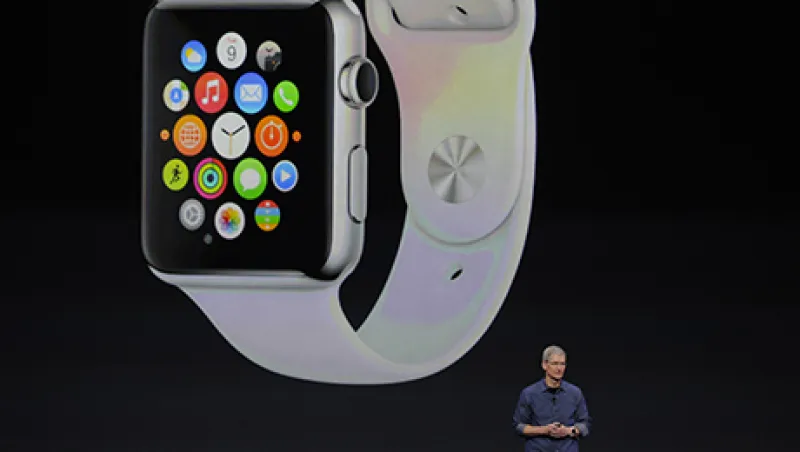I have to admit I was not able to get anything done on Tuesday when Apple released its new iPhone, Apple Pay and Apple Watch — absolutely nothing. Like millions of others, I was glued to my iPad watching Tim Cook do a two-hour Apple infomercial. (And unlike any other infomercial, I watched it twice.) The interest must have been greater than even Apple expected, as its website simply could not handle the traffic and kept crashing. A lot of viewers must have been sleep-deprived Chinese; it was 1:00 am in China, and Cook’s keynote was simultaneously dubbed in Mandarin. Apple’s emphasis on China makes a lot of sense, of course: The country is Apple’s biggest growth driver, with 4G just being rolled out there.
The release of the new iPhones was important for Apple in the short run — it desperately needed to introduce larger phones to battle Android handsets. Both the 4.7- and 5.5-inch phones looked terrific. However, the fact that Apple introduced two sizes may have an interesting consequence: Consumers will need to hold the actual phones to figure out which one fits them best. Online orders will likely be lower than usual, while traffic to Apple Stores will explode over the next several weekends (by the way, that will benefit other mall retailers). However, what is now known as the Apple Watch is really important for the company in the long run. Apple’s competitive advantage lies in its ecosystem, as its software allows you to easily connect and communicate with other Apple users.
But this competitive advantage — Apple’s moat — has gotten narrower and shallower as non-Apple apps that work across all platforms have gotten better and better. For instance, Facetime is successfully threatened by Skype, Viber and many other communications apps. Also, iTunes became less and less relevant as music streaming services such as Pandora and Spotify emerged. Escaping from the Apple ecosystem is easier today than it was a year or a few years ago. A strong brand, familiarity and ease of use are still advantages that clearly set Apple apart from its competitors, but the company has a weaker hold on you than if it made products that made switching painfully difficult.
Apple is very much aware of this fact, which is why it is introducing seamless integration of iDevices and Mac computers through its new iOS 8, which is being released next week, and OS X Yosemite, coming later this year. Soon, when you are working on your MacBook Air and get a call on your iPhone, a caller ID will flash on your computer screen, giving you a choice of answering the call on either device. Or if you start composing an email on your iPhone, you will be able to continue writing it on your iPad or MacBook.
The Apple Watch is important not just because it will provide another meaningful source of revenue but because, like the interlinking of devices created by Apple’s new operating systems, it too will widen the company’s moat. The Watch will keep existing iPhone and iPad users in the Apple ecosystem while stealing new customers from Android. (Also, since Apple now has large-screen phones, the last excuse to stay with Android is gone.)
When Tim Cook presented the Apple Watch, at first I was disappointed. I had envisioned a futuristic bandlike bracelet. However, I realized that with its new watch Apple was able to achieve something that only Apple could do — it created an individualized fashion accessory. Think about it: If Apple had designed a sleek, bandlike watch and it was a commercial success, everyone around you would be wearing the same bracelet, maybe with a few variations in color. But we are humans, not drones, and we need to express our individualism, which is exactly what Apple’s new watch will let us do.
Apple came out with three watch collections: Watch, Watch Sport and Watch Edition. All told, we counted 18 bands and six cases, that is, 108 combinations. However, that is nothing compared to what will come: Apple just gave birth to a new Apple Watch accessory industry that will be making case covers and bracelets for the new watch. What is also amazing is that since the high-end collection comes in an 18-karat gold case, I would not be surprised to see jewelry and even watch brands (think Tiffany, Gucci, or Cartier) start making fancy Apple Watch accessories for their affluent customers. It goes without saying that such companies wouldn’t be caught dead making accessories for Moto 360 or LG watches. That is the value of Apple’s brand.
The Apple Watch also comes in two sizes, small (38mm) and large (42mm), and so the media have hailed it as a watch for both men and women — and they are right, except that excludes an important demographic: children.
Do we really need another gadget? I vividly remember how everyone thought we didn’t need iPads, since we already had laptops and iPhones. (By the way, remember how much everybody hated the name?) But the iPad had its purpose — we just didn’t know what it was yet, and now we can’t imagine our lives without it. (How do you watch a movie on Netflix when you are in the bathroom?) Don’t let the name Apple Watch fool you; timekeeping is the least important function of this product. The iPhone is a gadget with which you check email, browse the internet, play games, check the weather, it’s your GPS — and somewhere near the end of the list, oh yeah, it makes phone calls.
Just because the Apple Watch sits on your wrist and tells time doesn’t make it a watch. It is a device that will let you do a lot of things you’ve done in the past through your iPhone, except now it will be a little more convenient to do them. In addition, the new vitals sensors will also turn it into an exercise accessory. I am personally looking forward to its working with a cycling app like Strava to show me my speed when I bike. Somewhere at the end of a very long laundry list of useful tasks it will do (we just don’t know all of them yet) the Apple Watch will show me the time as well, so at least now I won’t need to look for my phone to tell me the time.
The first version of the Apple Watch will likely be far from perfect, but that was the case with the first versions of the iPhone or MacBook Air and they were both very successful products. Charging the watch every night is not ideal, but the battery life of the first iPhone was not great either. Somehow we forgave Apple this imperfection because the positives far outweighed the negatives (and maybe because we forgive Apple more than other companies). My Blackberry phone in 2006 had a standby time of several days, if not weeks, but other than making calls and handling email, it couldn’t do anything else.
The Apple Watch today is superior to smart watches offered by other companies, which are for the most part extended displays for Android phones. Yes, Apple’s product does rely on the iPhone for GPS and 4G radio, but the Apple Watch is a minicomputer that can store data and run apps independent of the iPhone.
Apple’s competitive advantage has also been enhanced by the introduction of Apple Pay. Maybe by sheer luck, this is the perfect time to introduce such a product. Retailers are being attacked by hackers and are looking for a more secure way to handle credit card transactions. In 2015 responsibility for fraudulent payments will shift onto retailers and issuing banks if they don’t upgrade their credit card terminals to EMV (Europay, Mastercard, Visa), which will come equipped with the NFC (near field communication) sensor that Apple Pay requires. Also, Apple had a year to perfect the Touch ID sensor and work out its security kinks.
We are slowly transitioning to a cashless society. I don’t carry a wallet anymore, because my iPhone case houses two credit cards, my driver’s license and a few business cards. The health card and IDs that I used to carry with me are stored in my iPhone as photos. Apple Pay should take us a step closer to the cashless goal. I doubt Google will sit still, and Google Pay will probably come around, but it seems Apple has a solid lead here, too. Once you start storing all your credit card information in iTunes, switching from Apple to Android will become even more inconvenient — Apple’s moat just got wider.
As I look back at Apple’s keynote event and product introductions this week, my takeaway is that the company just became a little more valuable. In all honesty, I don’t know if the first-generation Apple Watch will be a great success or a modest success, but it will likely be a success. After all, it looks to be far superior to anything else out there. As an investor, I feel better about Apple today than I did last week.
My favorite moment from the Apple presentation had nothing to do with Apple. I was watching for the second time in the evening with my nine-month-old daughter, Mia Sarah. I had to watch it again, you see, because Apple’s website kept crashing when I viewed it live. Mia Sarah was sitting on my knees and intensely observing the proceedings; and every time the audience applauded — which happened every few minutes — she smiled, giggled and applauded too. I liked her doing it so much that we watched the whole presentation together (even the parts I had watched before).






